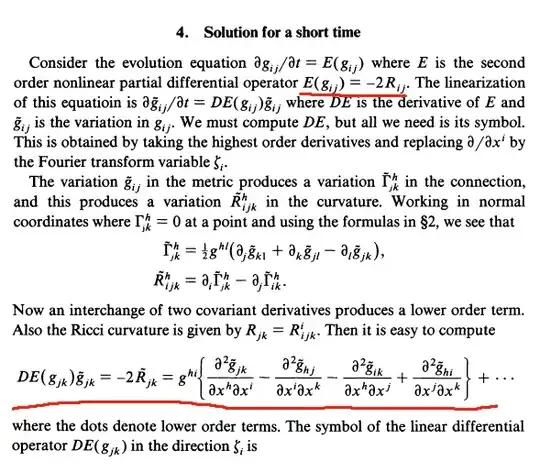Picture below is from the "Three manifolds with positive Ricci flow". I try to calculate the red line.
First, in normal coordinate, I have $$ E(g_{ij})=-2R_{ij} = \frac{\partial}{\partial x^i}(g^{kl}\frac{\partial}{\partial x^j}g_{kl}) - \frac{\partial}{\partial x^k}[ g^{kl}( \frac{\partial}{\partial x^i}g_{jl} + \frac{\partial}{\partial x^j}g_{il} - \frac{\partial}{\partial x^l}g_{ij} ) ] +(\text{lower order term}) $$ now $$ DE(g_{ij})\tilde g_{ij} = \frac{d}{ds}\Big|_{s=0} E(g_{ij}+s\tilde g_{ij}) $$ I don't know what is the inverse of $g_{ij}+s\tilde g_{ij}$. For example, to calculate $$ \frac{d}{ds}\Big|_{s=0} \frac{\partial}{\partial x^i}[(g_{kl}+s\tilde g_{kl})^{-1}\frac{\partial}{\partial x^j}(g_{kl}+s\tilde g_{kl})] $$ how should I get the elements of $(g_{kl}+s\tilde g_{kl})^{-1}$ ? But seemingly, since it is normal coordinate, $\frac{\partial}{\partial x^j}g_{kl}=0$, so there must be $$ \frac{\partial^2}{\partial x^i \partial x^j}g_{kl} $$ therefore, $(g_{kl}+s\tilde g_{kl})^{-1}$ become $g^{kl}$. But why $$ DE(g_{jk})\tilde g_{jk}=-2\tilde R_{jk} ~~~? $$ After all, the lower order terms are omitted. How to see that it is equal to $-2\tilde R_{jk}$ ? Seemingly, it is a directly calculation!
